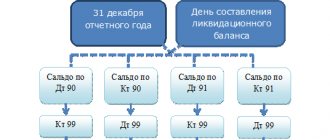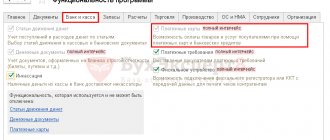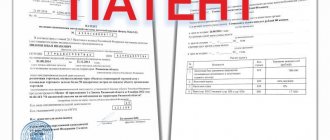Short Game
By the end of the tax period, all business entities that legally apply the simplified tax system with the object “income minus expenses” (hereinafter referred to as the simplified tax system D-R) are required to calculate the amount of the least tax. At the same time, according to Art. 346.19 of the Tax Code of the Russian Federation, the tax period is taken to be a calendar year.
Please note right away: the minimum tax is calculated only by simplifiers with the object “income minus expenses”. If a company or individual entrepreneur pays this tax only on income, then there is simply no need to determine the tax minimum for objective reasons. No matter what, but there is always income.
If a company or merchant using the simplified tax system with the object “income” calculates a suspiciously small amount of tax to be paid to the budget, this fact will certainly be of interest to tax authorities. For them, this is immediately a “beacon” that part of the profit is hidden from the state.
Minimum tax under the simplified tax system
The Ministry of Finance of Russia, in letter No. 03-11-11/32084 dated April 21, 2020, recalled the procedure for paying the minimum tax when applying the simplified taxation system.
What is the minimum tax
During the year, simplifiers pay advance tax payments. The amount of the quarterly advance payment is calculated based on the results of each reporting period based on the tax rate (15%) and actual income and expenses.
Simplified people will not be able to increase their expenses so much as to reduce their income to zero and not pay a single tax at all. Officials have foreseen this.
The fact is that the amount of the single tax cannot be less than 1% of the income received (clause 6 of Article 346.18 of the Tax Code of the Russian Federation). This is the so-called minimum tax.
Therefore, the resulting single tax amount is compared with the minimum tax.
If the single tax turns out to be less than the minimum tax, then the amount of the minimum tax must be paid to the budget.
If the single tax turns out to be more than the minimum, then the amount of “real” tax must be paid to the budget.
Please note: the minimum tax is calculated not from the difference between income and expenses, but from the sum of all receipts.
The minimum tax is calculated only based on the results of the tax period (year). There is no need to do this at the end of a quarter, half a year, or 9 months.
How to take into account the difference between actual and minimum tax
If the minimum tax turns out to be more than the “real” one, then next year you will be able to include the difference between them in expenses (clause 6 of Article 346.18 of the Tax Code of the Russian Federation).
But it is impossible to take this difference into account when paying quarterly advance payments for the single tax. This can only be done when calculating the single tax for the year. Therefore, “last year’s” difference is shown in the annual return for the next tax period.
The minimum tax will have to be paid even if the company suffered losses (that is, its expenses exceeded its income). In this case, the amount of “real” tax will be zero. Therefore, the difference between the minimum and the “real” tax will be equal to the amount of the minimum tax. This amount will need to be taken into account in expenses when determining the tax base for the next tax period, that is, in the annual declaration.
The declaration form was approved by order of the Federal Tax Service of Russia dated February 26, 2016 No. ММВ-7-3/ [email protected] The amount of the minimum tax is reflected on line 280 of section 2.2 of the declaration. And if the minimum tax turns out to be more than the “real” one, then, in addition to line 280 of section 2.2, its amount is indicated in line 120 of section 1.2
Minimum tax and loss carryover
By the difference between the amount of the minimum tax paid and the amount of the “real” tax, you can increase the amount of losses of the next tax period, which are carried forward to the future (clause 6 of Article 346.18 of the Tax Code of the Russian Federation).
This situation arises if, based on the results of work next year, the company again receives a loss.
The loss received during the year can be carried forward to the next year. It can be carried forward to any of the next nine years in part or in full. The remaining part of the loss can be transferred to other years, but for no more than nine years (Clause 7, Article 346.18 of the Tax Code of the Russian Federation).
If the “simplifier” suffered losses in more than one period, then they are carried forward to the future in the same sequence in which the payer incurred them. The Ministry of Finance of the Russian Federation recalled this in a letter dated May 27, 2019 No. 03-11-11/38174.
Let us note that the simplifier is obliged to keep documents confirming the amount of loss incurred and the amount by which the tax base was reduced for each tax period. The storage period for these documents is the period for reducing the tax base by the amount of the loss plus four years after the end of the year in which the loss was finally written off (subclause 8, clause 1, article 23, paragraph 7, clause 7, article 346.18 of the Tax Code of the Russian Federation).
How to take into account the minimum tax
The accrual of the minimum tax payable (instead of a single tax) is reflected by the following entries:
Debit 99 Credit 68 subaccount “Minimum tax calculations”
— the minimum tax has been calculated at the end of the year.
Debit 99 Credit 68 subaccount “Calculations for single tax”
— previously accrued additional amounts of advance payments for the single tax were reversed.
The difference between the paid minimum tax and the single tax does not need to be reflected in any accounting entries.
Reaching the minimum tax
The tax rate according to the minimum tax scheme is applied in cases where its amount turns out to be greater than the tax calculated according to the general “simplified” rules. In other words, when, based on the results of the past year, one can state almost a loss. Therefore, the size of the gap between income and expenses will ultimately determine what exactly to pay to the treasury:
- Regular tax on the simplified tax system.
- Get off with the least tax (although in any case it will be higher than the first option).
According to the position of the Tax Service, in the case of combining several tax regimes, one of which is the simplified tax system D-R, the state levies a minimum tax on profits that are received only from the simplified tax regime.
It is possible that the minimum tax will have to be calculated and paid at the end of the reporting period. This happens when an individual entrepreneur or a company loses the right to this special regime during it. This means that the minimum tax (if the indicators are based on it) is transferred based on the results of the corresponding quarter in which the right to the simplified tax system D-R was lost. In this situation, there is no need to wait until the end of the calendar year.
Keep in mind: it will be considered a violation of the law to presumptuously pay the minimum tax during the year. You cannot rely on pre-calculated losses or “zero” losses for the quarter.
How to correctly pay tax on the simplified tax system “Income minus expenses”
For taxpayers who work under the simplified tax system, the reporting period is the calendar year. It is during this period of time that the inspectorate checks the relevance of the information in the declaration. Advance payments are divided into quarters, and at the end of each quarter, contributions to the budget are transferred. In case of failure to comply with the established deadlines, fines will not be assessed, but penalties will have to be paid.
The payment terms for minimum payments are shown in the table:
| Reporting period | Payment deadline |
| First quarter | 25th of April |
| First half of the year | July 25 |
| Nine month | the 25th of October |
| Calendar year | Companies – March 31, individual entrepreneurs – April 30 |
Using a simple example, we will look at how to correctly calculate payments for paying tax with a simplified tax system of 15%.
- First quarter - income 426,000 rubles, expenses 378,000 rubles;
- Second – income 511,000 rubles, expenses 456,000 rubles;
- Third – income 387,000 rubles, expenses 324,000 rubles;
- Fourth – income 671,000 rubles, expenses 612,000 rubles.
According to the rules of tax reporting under the simplified tax system, it is necessary to indicate income and expenses on an accrual basis from the beginning of the year.
| Reporting period | Cumulative income | Cumulative expenses |
| First quarter | 426 000 | 378 000 |
| First half of the year | 937 000 | 834 000 |
| Nine month | 1 324 000 | 1 158 000 |
| Calendar year | 1 995 000 | 1 770 000 |
The advance payment based on the results of the first quarter is calculated using the formula: (426,000 – 378,000) * 15% = 7,200 rubles.
For six months, the contribution will be 15,450 rubles and is calculated as follows: 937,000 – 834,000)*15%. But 7,200 rubles (payment for the first quarter) should be subtracted from the amount received, leaving 8,250 rubles to be transferred.
Based on the results of nine months (1,324,000 – 1,158,000)*15% = 24,900 rubles. From this amount we subtract the taxes listed earlier and what remains is 9,450 rubles.
Similarly, we determine the amount of tax deductions at the end of the year, taking into account advance payments: (1,995,000 – 1,770,000)*15% – (7,200 + 8,250 + 9,450) = 8,850 rubles. This is the amount that must be transferred to the legal entity. persons until March 31 of the following year. The total amount of taxes paid to the budget is 33,750 rubles.
Tax offset
Let's consider the situation: a business entity made advance payments to the treasury under the simplified taxation system. In the case of the simplified tax system D-R, the question arises: can these payments be taken into account in the amount of the minimum tax? The answer is yes.
The tax return form under the simplified tax system has the following offset procedure. That is, the payer transfers advance payments to the amount of the minimum tax within the framework of this document. There is no need to submit a separate application.
In case of underdistribution of advance payments, they can be counted in the future as advance payments under the simplified tax system. Duration: over the next three years.
Advances and minimum tax
It is worth mentioning one more nuance related to the topic under consideration. It often happens that at the end of each quarter an entrepreneur pays advance payments for a single tax, and at the end of the year he is charged a minimum of 1%.
This situation can be sorted out using one of two methods.
The first method involves the entrepreneur paying the minimum tax under the simplified tax system and crediting previously made advances for a future period. Moreover, for this you do not need to do anything additional, since the offset occurs automatically, since the BCC for the minimum tax of the simplified tax system is no different. It is the same for both tax and advance payments.
Now about the second method. It consists of the entrepreneur crediting the advances paid towards the minimum tax. And in this case, the notorious KBK will be different. So you will need to write an application for offset of advances, to which copies of payment orders and details are attached. Before this, you need to submit an annual declaration so that the inspection database reflects information about the taxes paid by the person.
Accounting for expenses
Tax legislation provides for a procedure for accounting for the difference between the simplified and minimum tax for the previous year (clauses 6 and 7 of Article 346.18 of the Tax Code of the Russian Federation):
- It is included in expenditure indicators.
- It can also increase your losses.
Keep in mind: the difference can only be taken into account based on the results of the reporting period (year).
In simple terms, it is possible to include in expenses for 2021 the difference between the simplified and minimum tax, which was calculated and paid at the end of last 2018.
In any subsequent taxation period (up to 10 years), the accountant has the opportunity to include the specified difference in expenses or increase existing losses by it. The Ministry of Finance clarifies: you can immediately include in expenses the difference between the calculated and paid amount of the minimum tax and the tax that was accrued in accordance with the general procedure for taxation on the simplified tax system for several previous periods.
When to switch to the simplified tax system “Income minus expenses”
To understand better, let’s take as an example a business with a profitability of one million rubles and a high share of costs in the amount of 750 thousand.
In the case of working under the simplified tax system “Income”, the amount of the minimum tax for individual entrepreneurs is calculated in the amount of 60 thousand rubles: 1,000,000 * 6%.
If you use the simplified tax system “Income minus expenses”, you will have to pay 37,500 rubles: (1,000,000 – 750,000)*15%.
Despite the apparent benefit, the second option does not take into account such an important indicator as a reduction in the amount of tax by an amount equal to the insurance premiums paid for oneself.
Note that both regimes provide for accounting for all types of income, starting from an amount of 300 thousand rubles. Only the calculation methods differ. In the case of the simplified tax system “Income”, income is taken into account, and in “Income minus expenses” - the difference between income and expenses.
Courts of various instances have repeatedly noted the injustice of this situation, but officials of the Ministry of Finance and the Federal Tax Service insist: 1 percent is paid on income over 300 thousand rubles without taking into account the expenses of individual entrepreneurs.
Thus, the amount of the entrepreneur’s deductions for the turnover indicated above at the end of 2021 will be:
- Fixed contribution: 36,238 rubles.
- Additional contribution: 7,000 = (1,000,000 – 300,000)*1%.
The total amount for individual entrepreneur insurance will be 43,238 rubles.
This will allow the entrepreneur to reduce the amount of the calculated tax to 16,762 rubles if he works under the simplified tax system “Income” (60,000 - 43,238). In the simplified tax system “Income minus expenses”, insurance premiums are already taken into account in the reporting, so it is impossible to reduce the amount of deductions.
| Type of taxation | Single tax, rub. | Contributions for yourself, rub. | Total amount of deductions, rub. |
| STS "Income" | 16 762 | 43 238 | 60 000 |
| USN “Income minus expenses” | 37 500 | 43 238 | 80 738 |
Transition to simplified tax system
To work on the simplified tax system, a person must submit a corresponding notification to the tax office. In the case of registering a new business, the application is submitted after tax registration, but no later than 30 days after the date of registration. If for some reason you missed the specified deadline, then the general tax system is automatically assigned.
The transition to simplifying an existing business is possible only from the next reporting year. To do this, you also need to fill out and submit a notification about the transition to the simplified tax system before the end of the fourth quarter of the current year.
Right to special treatment in 2021
Most often, companies and individual entrepreneurs want to switch to a simplified taxation system in two cases:
- when they register for the first time and choose a tax regime;
- when they want to switch from OSNO.
This is only possible if the taxpayer meets the criteria established by Article 26.2 of the Tax Code of the Russian Federation.
Criteria for switching to the simplified tax system in 2021 for companies:
- the amount of income for 9 months of 2021 did not exceed 112.5 million rubles, and annual income did not exceed 150 million rubles;
- the number of employees under all employment contracts and GAP is no more than 100 people;
- the residual value of fixed assets for the year does not exceed 150 million rubles;
- the company has no branches (only representative offices are allowed);
- the share of participation of other companies in the authorized capital of a legal entity is no more than 25%.
For individual entrepreneurs, the list of necessary conditions for switching to a simplified system is slightly smaller:
- no more than 100 employees; the residual value of fixed assets does not exceed 150 million rubles;
- annual income does not exceed 150 million rubles.
Example of tax calculation in 2019
Individual entrepreneur N.P. Ivanov came out with the following performance indicators at the end of the reporting period:
- income – 1 million rubles;
- expenses – 950 thousand rubles.
Tax rate (USN D-R) – 15%.
The tax amount according to the general procedure: (1,000,000 – 950,000) × 15% = 7,500 rubles.
Minimum tax: 1,000,000 × 1% = 10,000 rubles.
It is clearly seen that the minimum tax (10,000 rubles) is more than the amount that had to be paid to the budget according to the general rules for calculating tax on the simplified tax system (7,500 rubles). It follows from this that the treasury should receive a minimum tax amount of 10,000 rubles.
Read also
24.03.2019





